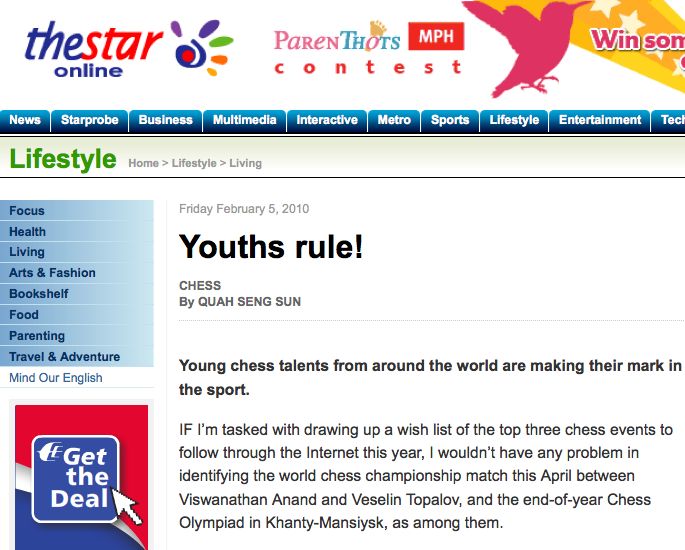Young chess talents from around the world are making their mark in the sport.
 IF I’m tasked with drawing up a wish list of the top three chess events to follow through the Internet this year, I wouldn’t have any problem in identifying the world chess championship match this April between Viswanathan Anand and Veselin Topalov, and the end-of-year Chess Olympiad in Khanty-Mansiysk, as among them.
IF I’m tasked with drawing up a wish list of the top three chess events to follow through the Internet this year, I wouldn’t have any problem in identifying the world chess championship match this April between Viswanathan Anand and Veselin Topalov, and the end-of-year Chess Olympiad in Khanty-Mansiysk, as among them.
The third? This has got to be a no-brainer choice for me. It can only be the annual tournament at Wijk aan Zee in the Netherlands. Chess people know it better as the Corus chess tournament.
The Corus chess tournament goes back a very long time but in those old days, the event wasn’t known as Corus. That came much later in year 2000. When the event began in 1938, it was known simply as the Hoogovens tournament, named after the Dutch steel and aluminium producer, Koninklijke Hoogovens.
In 1999, this company merged with British Steel and the new entity became the Corus Group.
So this tournament is steeped in history. Earlier this week, the latest in the long line of Corus chess tournaments ended in Wijk aan Zee. Its main attraction was the 14-man Group A event that featured some of the world’s top players, including Viswanathan Anand (the current world chess champion), Vladimir Kramnik (a previous classical chess world champion) and Magnus Carlsen (currently the highest-ranked player in the world).
The other participants included some of the most well-known veterans in international chess: Alexei Shirov, Vassily Ivanchuk, Peter Leko and the evergreen Nigel Short.
Chess today is dominated by younger players. Apart from Carlsen, 19, the other “babies” of the Group A tournament were Sergey Karjakin (20), Hikaru Nakamura (22) and Fabiano Caruana (17). But of course, how can I call Carlsen a baby when he is presently the highest ranked player in the world and was a co-winner at Corus two years ago?
And in all seriousness, Karjakin is no baby chess player either, because he has impeccable chess credentials. He started off in Corus this year as the defending champion but his crown was snatched away by Carlsen.
So there we have it, in the last three years the most significant feature of the Corus chess tournaments was the domination of teenaged chess grandmasters. Carlsen was only 17 when he became a joint winner in 2008.
Karjakin was 19 when he won the event in 2009. And now in 2010, Carlsen has won the tournament outright at 19.
By the way, Carlsen wasn’t the only teenager making a great splash at this year’s Corus event. In the Group B tournament, another teenager was creating a lot of interest: Anish Giri, 15, of the Netherlands. Giri, whose father is Nepalese, was born and raised in Russia. In February 2009, he qualified as a chess grandmaster and at that time, he was also the world’s youngest. Giri won the Group B event ahead of many of his contemporaries.
For good measure, I also want to mention that the Corus Group C tournament was won by Li Chao, 20, from China. Li will get his chance to play in the Group B tournament next year, just as Giri will also get his chance in next year’s Group A tournament.
This week, I’d like to feature an exciting game that was played in the final round of the Corus Group A tournament between Shirov and Leinier Dominguez.
At the critical point in the game when the two players agreed to a draw, Shirov was actually winning. However, chess is not played on position alone. There’s also the time factor to contend with and both players were tremendously short on time at that stage of the game.
After the game, Shirov discovered that had he pressed on to win the game, he would have won the tournament too, overtaking Carlsen at the top of the standings.
White: Alexei Shirov
Black: Leinier Dominguez
1.e4 c5 2.Nf3 d6 3.d4 cxd4 4.Nxd4 Nf6 5.Nc3 a6 6.Bg5 Nbd7 7.Bc4 Qb6 8.Bb3 e6 9.Qd2 Be7 10.0–0–0 Nc5 11.f3 Qc7 12.Kb1 0–0 13.g4 b5 14.a3 Rb8 15.h4 Bd7 16.Bxf6 Bxf6 17.g5 Bd8 18.h5 a5 19.g6 Nxb3 20.Nxb3 fxg6 21.hxg6 h6 22.Nxa5 (The start of all the complications. White could have chosen the straight-forward 22.Qxd6 and won a pawn) 22….Rxf3 23.e5 Be8 24.exd6 Qxa5 25.Rxh6 gxh6 26.Qxh6 Bf6 27.d7 Bxc3 28.dxe8Q+ Rxe8 (White needs to be very careful because a careless 29.Rd7 loses to 29….Rf1+ 30.Ka2 Ra1+ and he will be checkmated) 29.Qh1 (This could easily have been the Move Of The Game, a quiet sort of move that protects the back rank and now really threatening 30.Rd7 next) 29….Re7 30.Qxf3 Bg7 ½-½ (White should be winning after 31.b4 Qc7 22.Qa8+ Bf8 33.Rf1 etc)
